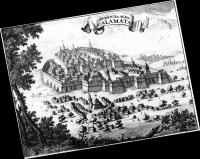 The castle
and the city
of Kalamata
in 1688 FROM THE CASTLE TO MARCH 23 SQUARE
The castle and the historical neighborhood that surrounds it form the oldest hub of the city of Kalamata. A plethora of religious monuments and buildings located here illustrate the city’s history in a most vibrant and colorful way. Many of these buildings have been turned over to new uses and are being wonderfully renovated to host cultural activities. The castle
The castle of Kalamata, the centerpiece of Angelos Terzakis’ celebrated novel Princess Isambeau, has become integrated into the city’s urban fabric and is typical of the castles built by the Franks in the Peloponnese in order to rapidly assert their dominance. The castle has been attributed to the Villehardouins, the historic family that established the Principality of Achaea. Over the centuries, however, the castle often found itself at the heart of conflicts; it was seized by the Byzantine armies, Franks, Albanians, Venetians and Ottomans and played an integral part in the city’s history all the way through the 19th century. 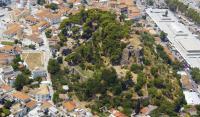 The castle seen
from above
The fortifications around the hill that are still visible today were mostly created during the period following Frankish rule (early 13th century). According to «The Chronicle of Morea», when the Franks occupied the city the castle was a scraggy, insignificant Byzantine fortress which had been converted into a monastery, and fell easy prey to the knights of the Fourth Crusade. The castle of Kalamata was offered by William of Champlitte to Geoffrey I of Villehardouin, prince of Achaea, as his personal fiefdom. He renovated, expanded and fortified it. Construction work was completed during William II’s reign. In 1293 the castle was seized by the Slavs of neighboring Yiannitsa, who stormed straight up the stairs to the top of the main tower. Once it was re-occupied, by Florent II of Hainaut, husband of Isabelle Villehardouin, the walls were made higher in order to thwart similar attacks. A part of the Frankish castle was demolished by the Venetian conquerors of Francesco Morosini (1685), to be rebuilt considerably stronger. 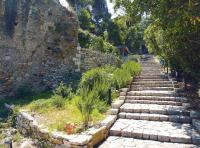 Τhe interior
of the castle The present-day appearance of the castle is the result of additions made by the Turks during the first period of Ottoman rule, by dilapidation suffered in 1658 and 1825 and also because building material was removed to construct the houses and schools of Kalamata. Visitors may still make out traces of the outline of the Frankish castle dotted around the hill, while a row of fortifications runs north-to-south along the hill’s plateau. A second defensive front was built along the vulnerable eastern flank of the hill. Both walls follow the curvature of the natural landscape and are built perpendicular to the ground. No battlements survive. The castle’s keep (or donjon), built on the most precipitous part of the hill in the northeastern corner of the inner courtyard, is still visible today. 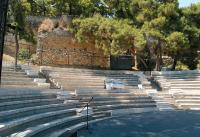 The small
theater in the
castle was
built at 1950’s Little has survived of the tower other than fragments of its lower level, the northern section of which occupies a large domed rectangular cistern. In the southern section there is an almost square area covered by a low dome-shaped building without openings. According to some researchers this room may be what remains of the church of the monastery mentioned in «The Chronicle of Morea». Externally, on its eastern side, the tower has been heavily fortified by a curtain wall. This fortress is the only one in Messenia to have survived the passage of time at this height. 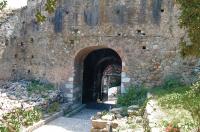 castle
entrance After a devastating earthquake in 1986 many sections of the castle were cordoned off as being potentially hazardous. Nevertheless, there are several parts that can be visited and which offer a panoramic view of the city of Kalamata and its environs. A small theater has also been built at the southern end of the castle, hosting dance, music and theater performances during the summer. The churches around the castle
Kalamata’s New Market is located northwest of the city’s castle, while there is also an early 19th century church nearby, under the northwestern battlement, called the Church of Aghios Dimitrios. An unnamed church located at the northwestern corner of the castle is dubbed by some as that of Panaghia Kalomata, or the Beautiful-Eyed Virgin, after which some believe the city gets its name. 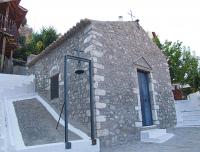 Aghia Kyriaki A small wooden-roofed church, that of Aghia Kyriaki, is located near the castle’s southwestern entrance. This church served as a chapel to the Kalograion Monastery and is believed to have been built sometime in the 17th century, though it has undergone numerous alterations over time. At the foot of the castle and near the sanctum of the previous church, one may see the Church of Aghios Ioannis Prodromos nestled at the mouth of a cave. Dating possibly to the late Byzantine period, the church still contains a number of faded murals. 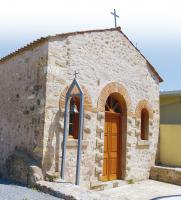 Aghios
Georgios Southeast of the castle, on Alagonias Street, deep in the fabric of the old town, lays the Church of Aghios Georgios, which served as the first metropolitan church of Kalamata and was replaced by the Church of Ypapanti, which was erected in the mid-19th century. Its present-day form – a large single aisle, wood-beamed ceiling and a three-sided nave – is the product of numerous interventions and repairs over its long history. The church’s history is outlined on a marble plaque dated to 1939 which is embedded into the interior southern wall. Highlights of this history are an attack suffered under Ibrahim Pasha and the blessing of the Governor of Greece Ioannis Kapodistrias and King Otto when they visited the city. 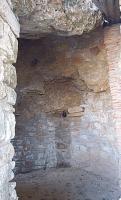 Church
of Aghios
Ioannis
Prodromos The church is believed to have been originally constructed during the second Venetian occupation (1685-1715), while a second phase of construction began after a destructive 1844 earthquake and was completed in 1939. Starting in 1986, the northwestern and southwestern corners of the church, as well as a section of the southern side, were rebuilt. 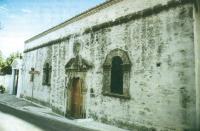 The main
church
of the
monastery The Kalograion Monastery
Southeast of the castle, at its beautiful fringes (14 Mistra Street), is the Kalograion Monastery (or Monastery of Nuns), whose residents (numbered at 23 today) are famed for producing silk, an activity that has earned both the nunnery and the city widespread acclaim and has been awarded in Greece and abroad. The monastery was established in the late 18th century (1796) by the priest and teacher Gerasimos Papadopoulos (1763-1844), who was born in Kalamata and studied at the famous school in the town of Dimitsana which had produced many of the country’s intellectuals and war heroes. His tomb is located in front of the altar in the monastery’s main church. 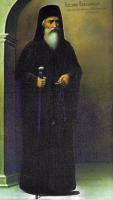 Monastery
founder,
cleric and
teacher
Gerasimos
Papadopoulos
(1763-1844) The Kalograion Monastery was pillaged by Ibrahim Pasha, went back into operation, was dissolved in 1834 at the orders of the Regency of Otto, who shut down several monasteries, and was eventually re-occupied by nuns. Today visitors enter the monastery through the wrought-iron gate on Mistra Street, which leads into a beautiful orange grove that contains the monastery’s main church (katholikon) and the Byzantinestyle Church of the Timios Stavros (Holy Cross), built during the 1978-83 period. Four imposing residential wings rise above, which during the 1952-80 period replaced the cells of the older monastery. 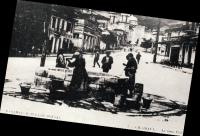 Ypapanti Street, which
connects the homonymous
church and the castle to
the Church of the Holy
Apostles, was known, up
until 1937 as Megali
Pigada or Great Spring
(seen here in an old post
card). The main church of the monastery today is the Church of Aghios Constantinos and Eleni, the most significant – because of its sheer size – Byzantine church in Kalamata. This singlevaulted wood-ceiling church has been through various phases of construction over the course of its history. Of the original walls (built during the11th-12th century), which were dressed with plinth, all that remains is a small section in the nave and another on the southern side of the church. The original building bore many similarities to the Church of the Aghi Apostoli (Holy Apostles). Later, likely in the 17th century, the church was extensively altered, while some of the openings on its northern wall were rebuilt to the Venetian style of church architecture. During the Greek War of Independence the church was burnt down by Ibrahim Pasha and later repaired in the 19th century, while even later a narthex was added to the western side of the building. 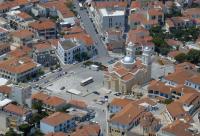 Ypapanti Square Ypapanti Square
The area around Ypapanti Square (south of the castle) was the first to be inhabited outside the castle’s walls in more recent years. Naturally, excavations of the area in the past revealed the foundations of a large building from antiquity. The square is dominated by the majestic Metropolitan Church of Ypapanti tou Sotiros, with its two bell towers and imposing domes. The same location once held another church, which was destroyed by Albanian mercenaries working for the Turks in 1770, as well as a later church, which was also destroyed, by Ibrahim Pasha in 1825. 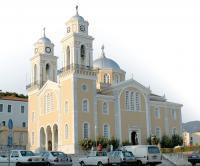 The Church of
Ypapanti The church was rebuilt only to suffer extensive damage during the 1843 earthquake. It was rebuilt anew and inaugurated in 1854. The cathedral we see today began being built in 1860 and went into operation in 1873. Earthquakes in 1886 and 1986 took their toll, but in both cases the church was repaired. Southeast of the church, in the courtyard, one can see a large stone cross, enclosed in railings, marking what was most probably the spot where the Church of Ypapanti, which was destroyed in 1770 and then used by conquering armies as stables, once stood. 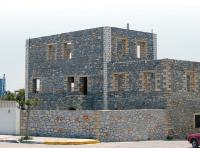 The Karfiotiaki
Mansion is being
renovated into the
new Ecclesiastical
Museum According to local lore, a half-burnt icon of the Virgin was found here after one of the city’s nobles, P. Tzanes, saw it in a dream. February 2, the saint’s day of Ypapanti the Virgin, is feted with great pomp and ceremony at the church every year. Ceremonies begin on January 27 and end on February 9 in a festive all-night vigil. During Ottoman rule, the Korfiotiaki Mansion – leased between 1816 and 1821 by the elders of the city to serve as the home and courthouse (konaki) of the judge of the administrative district of Kalamata, Suleiman Arnautoglu – used to stand at the southern end of the square. 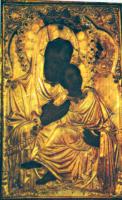 The holy icon of Ypapanti The dilapidated building is now being restored into the city’s new ecclesiastical museum. On the northeastern side of Ypapanti Square, in the grounds of the Alexakis Tower, is the Church of Aghi Anargyri, a singlevaulted, wooden-ceiling church with a triple apse on its eastern facade that is dated to the post-Byzantine period (the second period of Venetian rule) and which has undergone numerous alterations over time. 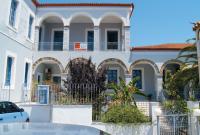 The Kalamata
Conservatory North of the church and square of Ypapanti, on the corner with Alexandraki Street, is the Kalamata Conservatory, which was renovated after suffering earthquake damage. The building is a wonderful sample of the early Neoclassical style (1860), build in a , with three storeys and a ceramic-tiled roof. The interior courtyard boasts a portico with arched stone colonnade. The building used to house, respectively, the Church of the Virgin, the first boy’s high school of Kalamata and other secondary education schools. At the northeastern end of the square stands the Alexandrakeio Retirement Home, which was bequeathed to the city by one of its greatest benefactors, Spyridon Alexandrakis. 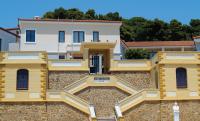 Alexandrakeio Retirement Home Originally (in the late 19th century) it functioned as a hospital and shelter for the needy, turning itself over to its present-day operations in 1940. 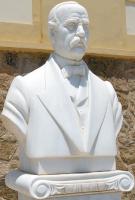 Spyridonas
Alexandrakis The two-storey, ceramic-tiled Neoclassical building on the southern side of the square (at 36 Ypapanti Street), which dates to the 1890 - 1910 period and where one can admire marble balconies, simple corbels and wrought-iron railings, now houses the State Records and Records of South Messenia offices. This is a regional service of the State Records Office, which was founded in 1991 in order to safeguard the region’s historical and cultural heritage. (Tel. 27210 93902. Library hours: 8:30-14:00). The Record Office of Messenia contains a significant number of public and private records, collections, architectural drawings, maps, newspapers, photographs, etc. The organization collects, restores and files its archives, while also organizing a number of events and educational programs. Ypapanti Square is also where the Municipal Library of Kalamata is located. Operating since 2004, the library promotes the city’s educational, informational and cultural objectives. 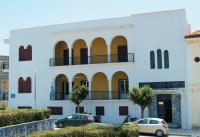 Kalamata Municipal Central Library South and southeast of Ypapanti Square
If we head southeast away from Ypapanti Square along Faros Street, we pass by the Metropolitan Mansion to reach Frangolimnas Square, formerly a marshland that was filled in in the 19th century. 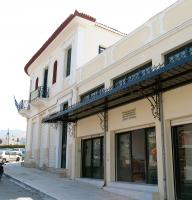 General State
Archives/Archives
of Messinia On Mitropolitou Meletiou Street, running along the western side of Frangolimnas, we see a «double» church. The main part of it is comprised of the Church of Aghios Nikolaos, a single-vaulted building with a pitched roof that dates to the early 18th century. A triple apse juts out from the eastern flank of the church, while the walls are made of stone. The icon screen is built-in and adorned with plaster decorative features from the early 20th century, while one can also see the wooden false roof. The chapel of Aghios Athanasios Tzane, a single-vaulted building with a triple apse dated to the early 20th century and located on the south side of the main curch, is the second part.  Metropolitan
Mansion The Church of Aghios Nikolaos Efesiou, dated to the 19th century and displaying a number of Neoclassical features, is also located on Mitropolitou Meletiou Street, on the northeastern side of Frangolimnas Square. At number 10 of the same street, we come across the city’s Military Museum. Operating under the supervision of the General Chief of Staff, it is housed in a building ceded by the Metropolitan of Messenia. Its displays focus on Greek history from the 1821 War of Independence to the present day. Across the southeast side of the square is situated the old Karelia tobacco plant. 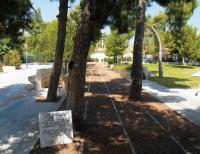 A memorial plaque in Frangolimnas Square,
dedicated to the test-games that took place here
before the first Olympic Games of 1896 Following Mitropolitou Meltiou onto Iosif Androusis Street, brings us to the cemetery of Kalamata and the Church of Aghios Haralambos, which, during Venetian rule, was known as the Metropolitan Church. Even though its character has been somewhat compromised by many interventions over the years, it remains one of the most significant Byzantine monuments in the city.  The “double”
church The first phase of construction (12th century) is responsible for just the eastern part of the building, which served as the cemetery’s church even then. The original church has two stories and three triple apses on the exterior of its eastern wall. The ground floor has a simple two-column entrance, though it used to have a vaulted cross-shaped roof. The ceramic features decorating the exterior of the original walls (toothed bands, graded surfaces, crosses, etc.) are of particular interest, as is the extensive use of bottlenecks used to level the cornices of the original monument. The church suffered a significant amount of damage in the post-Byzantine period, followed by widespread interventions (17th-18th centuries), defined by the broad use of limestone cornerstones and the method used to place evenly-cut stones blocks instead of plinth bricks, as well as other architectural elements. An annex was added to the western side of the Byzantine church in the late 19th century, which today serves as the main church. The original core is used as the sanctum. 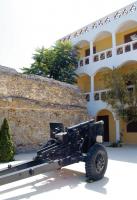 Military
Museum West of Ypapanti Square
West of Ypapanti Square, on the corner of Kyriakou and 12 Aghiou Ioannou, there is an early Neoclassical building (1870-1890), formerly belonging to the Kyriakou family, which today serves as the home of the Historical and Folklore Museum of Kalamata. This two-storey tiled-roof building displays notable architectural features and impressive wrought-iron balconies. The museum was founded by the local Literary Society and allows visitors to gain a representative picture of daily life in the region and of developments in local folk art during the 19th and 20th centuries. 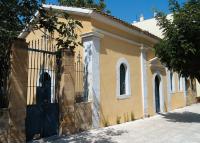 The Church of Aghios
Nikolaos Efesiou In the same area, we also see the square and Church of Aghios Ioannis Prodromos, one of the earliest parishes in the city. The church we see today was built on the foundations of a smaller church sometime in the second half of the 19th century. Recent evidence suggests that a glorification ceremony was held here to mark the liberation of the city from the Turkish yoke on March 23, 1821. Southern lies the Othonos square, where it used to be the market for local products. The new municipal market was constructed west of the castle, in the beginning of the 1980s. 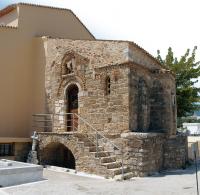 The cemetery’s
Church of
Aghios
Haralambos Southwest of Ypapanti Square
Southwest of Ypapanti Square, on the corner of Tzane and Ypapanti, we see the mansion of Panayiotis Tzanes, which was used by Petros Mavromichalis (commander-in-chief of the commoners’ revolutionary forces during the Greek War of Independence), as a warehouse for supplies during the same war. The Municipal Philharmonic Orchestra is also located in this part of the city. Ypapanti can also be exited via the pedestrian walkway of Benaki Street, southwest of the square. On the corner of Benaki and 6 Papazoglou, the Benakeion Archaeological Museum of Kalamata is a threestorey tiled-roof building constructed in the folk style (1850), which represents one of the city’s most notable monuments and was donated by the Central Archaeological Council to Antonios Benakis, son of Emmanouel (founder of the Benaki Museum in Athens) for the purposes of the museum. 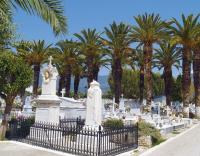 View of the cemetery Architecturally, worth noting are the building’s doors and windows, which on the ground floor are square with an arch, on the first floor plainer and larger, and on the second even larger, with wooden frames and jutting cornices. 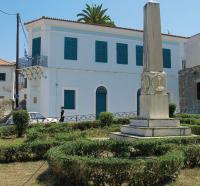 Historical
and Folklore
Museum South of the Municipal Gallery and the Benakeion Archaeological Museum we come across the roofed Old Market, the heart of the city of Kalamata ever since the inter-war years. The structure, which suffered extensive damage in 1986 earthquake, was handed over by the municipality to the Ministry of Culture to be used for the future Archaeological Museum of Messenia. Renovation work is almost finished and soon, the Old Market will open its doors once more. The museum will display, among others, numerous exhibits from the Benakeion Archaeological Museum, as well as more recent finds from excavations (a total of 1,000 items). Other than display halls presenting the history of the region, the building will also house offices of the Ephorate of Antiquities, restoration workshops, areas for hosting cultural activities, a gift shop, a cafe and a book store. 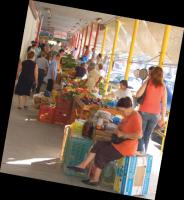 The new
municipal
market March 23 Square
This lovely, historic square can be reached by leaving Ypapanti Square from its southeastern side along the homonymous street. The Church of the Holy Apostles, a diminutive yet significant church that has become something of a trademark for the city, stands out on the northern end of the square. According to local history it was here that on March 23 (thus the name of the square) the Greek War of Independence was proclaimed. Today the church has two sections: the eastern, older part, which contains the sanctum, and the western side, which was added on as a more spacious hall and serves as the main congregation area. 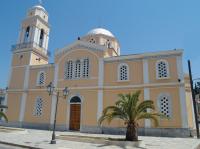 The Church
of Aghios
Ioannis
Prodromos The original section, built exquisitely with plinth-dressed stones and displaying wonderful ceramic decorative elements, is domed and structured as a free-style cross, and dated to Middle Byzantine era (mid-11th-12th century). The church also boasts a number of 14th century murals. There is a triple apse on the eastern side and on the western side there is a domed basilica, built in the 18th century (second Venetian occupation), with a bell tower located on the northeastern side of the original church in order to allow for more room for the congregation. During the construction of the annex the western part of the older church was removed in order to smooth out the differences between the two phases of construction. The church suffered extensive damage in 1986, but protracted renovation has returned it to its former glory. Moving southeast from March 23 Square via Stadiou Street brings us to Mavromichali Square, at the northern side of which the tower of Panayiotis Benakis once stood. 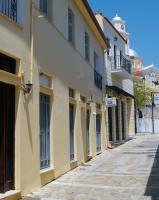 Benaki
Street The Church of the Minor Archangels, a dependency of the Velanidia Monastery, is on Valtetsiou Street at the front of Mavromichali Square. The church dates to the early 19th or late 18th century and is a single-vaulted, wood-ceiling church with a pitched roof and Neoclassical elements. The apse is centered and three-sided on the exterior. 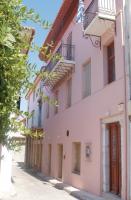 Papazoglou Street is also host to the newly
established A. Tassos Municipal Gallery of Kalamata
(at 5 Papazoglou). The space belongs to the
Municipal Organization for Cultural Development
and mostly comprises works by Greek artists
that were donated to the city following
the 1986 earthquake 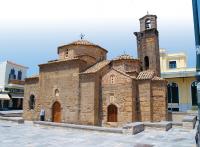 The
Church of
the Holy
Apostles 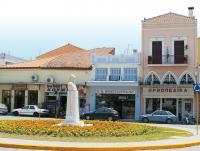 March 23
Square
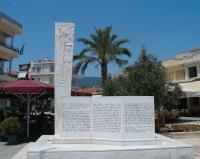 The Heroon (or heroes’ monument), at the center
March 23 Square, commemorates that historic
moment of the uprising. This modern work is by
Messenia sculptor Christos Riganas. |